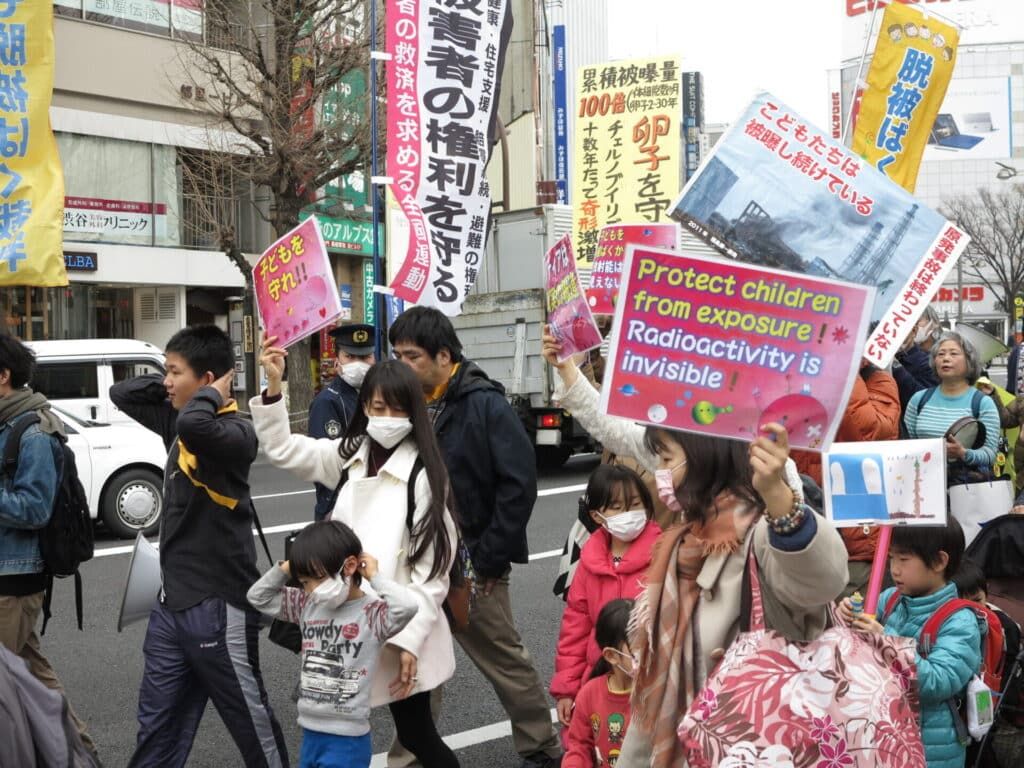Fukushima wastewater issue will further divide a nation, split families, and cause ‘atomic divorce’
By Maxime Polleri | October 17, 2023
 Mothers march in Tokyo against radiation exposure risks five years after the Fukushima nuclear disaster on March 5, 2016. (Photo by Maxime Polleri)
Mothers march in Tokyo against radiation exposure risks five years after the Fukushima nuclear disaster on March 5, 2016. (Photo by Maxime Polleri)
In a bid to dispel seafood worries around the release of Fukushima nuclear wastewater into the ocean, Japan’s Prime Minister Fumio Kishida ate an array of sashimi late in August; the raw fish ranged from flounder to sea bass caught in the Fukushima area. It is “safe and delicious,” he joyfully declared during a public relations effort to revitalize the fishing industry, which has been affected by a Chinese seafood ban and consumer anxieties over the wastewater release.
Many applauded Kishida’s comment, which echoes the same government narrative around post-Fukushima food safety, as well as his firm support for the release of tritium-contaminated water—a discharge process that the International Atomic Energy Agency stated complies with operational safety limits for radiation.
But as someone who studied the aftermath of the Fukushima nuclear disaster for more than a decade, I believe that this decision will irreversibly erode public trust and create irreparable long-lasting tensions. During my years of research in Japan as an anthropologist, I witnessed first-hand how state policies around Fukushima’s economic recovery are fragmenting communities, which constitutes an enduring catastrophe of its own.
Since 2011, in the hope of recovering from the worst nuclear disaster since Chernobyl, Japan has embraced an official policy of revitalization at Fukushima. The policy has different features, which all converge into a discourse of minimizing radiation risk, promoting Fukushima’s food products, and repatriating former evacuees. While this government’s policies have given the population some sense of normalcy, they have also been harshly opposed, which is at the root of the discord now caused by the government’s release of nuclear wastewater.
Minimizing radiation risk. Since March 2011, Japan’s government and state-mandated experts have repeatedly told the population that the levels of radiation released during the nuclear disaster at Fukushima were too low to pose any significant health risks, preferring to highlight their impacts on mental well-being instead.
Since March 2011, Japan’s government, state-mandated experts, and international organizations have repeatedly told the population that the levels of radiation released during the nuclear disaster at Fukushima were too low to expect any increase in cancers and other health effects in the future. But for many, fear and stigma related to the perceived risk of exposure to ionizing radiation are in fact perceived as the real risk. Throughout the years, these public relations efforts failed to convince parts of the population, especially after a survey conducted by the Environment Ministry revealed that children in Fukushima developed thyroid abnormalities. While some experts linked this increase in thyroid cancer among the youth to the radiation exposure at Fukushima, the government embraced another narrative, in which a “screening effect” led to the detection of thyroid cysts and nodules that would not otherwise have been discovered.
In this context of competing narratives, voicing concerns about the radiation safety at Fukushima has created internal community divisions, especially as the government’s discourse has been adopted by certain segments of the population. For instance, mothers who evacuated their children from Fukushima for fear of adverse health effects have faced backlashes from their own parents—who often refused to be evacuated—worrying about not seeing their grandchildren. In interviews I conducted in 2016, parents blamed their daughters’ decision to leave, often saying that: “The country’s leaders are saying that it’s safe, so why do you contradict them?”
Promoting food safety. Following the disaster, food safety became a contentious issue. Wary of contamination, many people stopped consuming food from Fukushima, which led to a drastic reduction in sales of food products. To revitalize Fukushima’s agriculture and fishery industries, the government established regulatory criteria and encouraged food consumption through public relations activities, saying, much like Kishida, that food was “safe and delicious.” In doing so, the government sought to fight what it calls “harmful rumors” around radiation risks, which lead people to avoid food products. But as with radiation safety generally, it is hard for citizens to voice concerns about food safety, despite independent testing showed cases of localized radiation contamination. As one mother explained to me: “Other members of the community will tell you to stop spreading rumors. So, it’s quite hard to express oneself directly.”
In Fukushima, mothers complained that neighbors watch their shopping practices. When the mothers do not buy products from Fukushima, they are accused of being un-patriotic and hampering the region’s revitalization. Such incidents inside local communities reminds us of the traditional practice of murahachibu—the shame-based social ostracism that was widespread in Japan during the Edo period of the 17th to 19th century and reemerged after the Fukushima nuclear disaster and, most recently, the COVID-19 pandemic. The Japan government’s plan to release radioactive wastewater into the ocean will likely exacerbate social ostracism within local communities even further.
Entangled between the social pressures to support their community and the need to protect their families as they see fit, mothers feel forced to make impossible choices. The mothers’ decisions to evacuate their children from Fukushima severely affect their family ties, even creating disagreements within couples in a new phenomenon called “atomic divorce.” To make things worse, in a country where the government declares Fukushima as being safe, evacuation is depicted as unnecessary. In line with its policy, the government announced in 2017 the termination of financial support for people who decided not to return to Fukushima. Masahiro Imamura, the Reconstruction Agency Minister, illustrated this decision by saying that, from now on, voluntary evacuees would be “self-accountable” for their choice.
Demands for evacuation are harder to justify now, and mothers who evacuated spoke of backlashes from their community, accusing them of living on state subsidies. “More and more we are being depicted as ‘annoying’ people,” one mother told me in 2016. Being a critic of the government’s policies at Fukushima is often kept secret, as individuals fear reprisals from their community. Mothers spoke of migoroshi—literally, “letting someone die”—to describe their situation as victims of community tensions created by post-disaster policies.
Nuclear wastewater’s social cost. Tragically, catastrophes and crises are often followed by severe social tensions and crises. Japan’s 2011 triple disaster—earthquake, tsunami, and nuclear meltdowns—is no exception. In Japan, such community breakdowns add a fourth disaster, which painfully lingers to this day.
The controversy surrounding the release of nuclear wastewater is already creating tensions very reminiscent of 2011. Currently, Japan is aggressively defending its position through a series of public relations messages exhorting citizens to eat Japanese marine products and stop spreading harmful rumors. Some citizens have answered this call, and the number of donations supporting Fukushima’s products have increased drastically. However, social media posts promoting food consumption are already derided or called out, ironically, for being “tasteless.” Fukushima’s mothers also worry that anxiety and divisions among residents will increase as they’ve done in the past. Even fishermen are divided about state supports, with 151 plaintiffs filling a lawsuit against the government to stop the wastewater release.
No science-based narratives will bridge these gaps. These are not issues of science, but concerns about how recovery is conceptualized, as well as who is expendable in post-disaster politics. For now, in a few delicious bites of fatty flounder, all these palatable tensions have vanished under an array of camera shutters and television crews. Until they resurface.
Together, we make the world safer.
The Bulletin elevates expert voices above the noise. But as an independent nonprofit organization, our operations depend on the support of readers like you. Help us continue to deliver quality journalism that holds leaders accountable. Your support of our work at any level is important. In return, we promise our coverage will be understandable, influential, vigilant, solution-oriented, and fair-minded. Together we can make a difference.















How does the Japanese government guarantee the release of contaminated water will not have long term adverse health affects? Especially when those affects may not be seen until years later when these same officials are themselves either retired or dead.
The radiation that tritiated water releases is a beta-minus particle with a low electron-volt potential so it does a bit of ionizing of surrounding tissue if ingested. It is not electromagnetic radiation such as x-rays or gamma rays. But the main problem is that when tritium releases that beta-minus particle, it is no longer a form of hydrogen, it becomes helium, so no longer can function as a hydrogen atom in whatever molecule it had been incorporated into.
Insane. Absolutely criminal, they could filter the water but don’t want to incur the expense from what I have read. I believe the Japanese govt should immediately seize control of the plant and oversee the filtration of the water to the point where it would be safe to release.
I don’t believe they could filter or neutralize such huge amounts of water. The disaster will escalate.